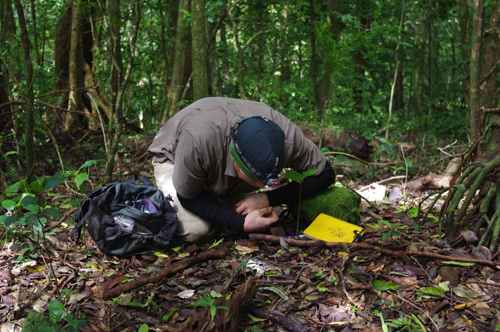
You might not think of packing your tuque and jacket for a visit to Costa Rica. But they’re required gear for U of G biologist Alex Smith, who spent the tail end of August in the Neotropics. Having made numerous field trips to the cloud forest some 1,500 metres up each of three volcanic mountains in northwestern Costa Rica, he knows to expect cool, wet conditions most of the time.
But even the integrative biology professor was surprised to learn something new there. What he’s observed during the past six years – detailed in a new paper released this summer – makes him worry about potential effects of climate change, not just on the hyper-diverse tropical rainforest but also on other ecosystems, including Canada’s North.
The Area de Conservacion Guanacaste (ACG) is a 165,000-hectare national park on Costa Rica’s coast, within view of the Pacific Ocean. It’s also a crucible of life.
This UNESCO World Heritage Site holds about 2.5 per cent of the world’s biodiversity. Some 375,000 kinds of plants and animals are packed into a patch of real estate no bigger than the Greater Toronto Area.
Smith – along with Winnie Hallwachs and Dan Janzen, both biologists at the University of Pennsylvania – has found that living quarters for all of those plants and animals are about twice as tight as scientists thought. Their study combining community ecology and DNA barcoding appeared in August in the journal Ecography.
Climb one of the volcanic mountains in the ACG, and you go from a dry tropical forest – up to 45 C in direct sun – through the rainforest to the cloud forest. In the upper reaches – dubbed “sky islands” – it’s always cool and misty. Wet periods bring “hypnotic, driving, penetrating rain,” says Smith.
Those changing environmental conditions favour different groupings of plants and animals. Ecologists had assumed that the mix of species in each of these vertical ecological communities changed about every 500 metres. Not so.
Using DNA barcoding to identify ants collected up the volcanic slopes, Smith and his colleagues found new species – markers of new ecological communities – much more frequently than expected.
Referring to the genetic method developed at Guelph to distinguish species of living things, he says, “Barcodes have helped show that communities are changing every 200 to 300 metres.”
Put another way, there are roughly twice as many different neighbourhoods as scientists had thought – each with its own blend of plants and animals – piled atop each other up the mountainsides.
Narrower diversity bands are more vulnerable to influences such as climate change, says Smith. Based on his monitoring of conditions – notably rain and temperature – and the mix of ant species, he says the area is already showing signs of just that. It’s becoming relatively warmer and drier at higher elevations than before, says Smith. Various plants and animals following those conditions upward might push out endemic species and irreversibly reduce biodiversity in each of those “neighbourhoods.”
Invasive species threaten endemic plants and animals in Canada as well, he says. A warming Arctic might experience similar changes as in the Neotropics, leading to a less diverse ecosystem.
Comparing rainforest ants to Canadian creatures, he says, “Whatever is happening to these insects over thousands of metres is happening across degrees of latitude here. With a warming, drying climate, this is probably what we will see in Canada over kilometres of latitude into the Arctic.”
Smith has worked in Costa Rica for a decade. The new paper is based on data collected since 2008. He says there are still unknowns about climate change effects, including differences between long-term climatic patterns and short-term weather changes.
The ACG is home to an estimated 1,000 ant species, or as many different kinds as you might find in all of North America.
Other rainforest residents include tapirs, pumas and jaguars, and various monkey species. He says howler monkeys make “one of the great ambient sounds of that place. It’s like wolves in Algonquin Park, big booming sounds that carry across the valleys and mountains.”
View photos from Alex Smith’s August 2014 research trip to Area de Conservacion Guanacaste: https://sites.google.com/site/acgantcollectionsaugust2014/journal-blog/140820—data-download-day
For a closer look at the insects he studies, check out Smith’s YouTube videos: https://www.youtube.com/playlist?list=PLMmwf4lO14xdvXsE0kCOmwIvHVsFzQYMM&action_edit=1.
GigaPan below by Prof. Alex Smith.